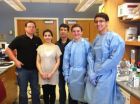(Press-News.org) Cancer clinicians and a chaplain at the Johns Hopkins Kimmel Cancer Center have developed a new tool to help doctors, nurses and other health care providers talk to dying patients and families who are, literally, praying for a miracle.
The AMEN (Affirm, Meet, Educate, No matter what) protocol, a script that can be used by medical staff, offers a way to negotiate these challenging conversations to affirm or acknowledge a patient's hope, share the patient's wish with others, continue to educate the patient and family about medical issues, and assure them that their health care team will remain with them throughout the duration of their care, "no matter what."
"The AMEN tool allows the provider to join the patient or family member as a fellow human being with hopes and aspirations, and fosters a sense of trust and commitment to care," said Rhonda S. Cooper, M. Div., B.C.C., the Cancer Center's chaplain.
In lectures at Johns Hopkins, she says, the tool has been presented to clinical staff as a way "to respect our patients' beliefs and values as we care for them to the best of our ability." Cooper and her colleagues described the conversational protocol online in the May 6 issue of the Journal of Oncology Practice.
According to Cooper, patients and their families often turn to the idea of a miracle during a serious illness or trauma. In a study cited by the researchers and conducted by the University of Connecticut and Georgetown University, 57 percent of adults randomly surveyed said they believed that "God's intervention could save a family member" even when physicians said that any further treatments would be futile.
Doctors and nurses may feel uncomfortable discussing miracles as a religious event, or feel that they do not have the training or time to talk about miracles, Cooper says, but adds it is important not to dismiss the idea when patients or family bring it up.
"If the provider makes a comment that sounds dismissive of God or the person's faith or beliefs, that definitely will affect the trust relationship," she says. "The goal of the conversation between provider and the patient or family is to stay connected, not debate the possibility of miracles happening or not happening."
The AMEN tool, which specifically consists of a recommended script for talking with patients, can help medical experts see the hope for a miracle as an opportunity to join the patient or family in their end-of-life conversation, Cooper says. The goal is to maintain trust and foster open and honest communication as the care plan is being discussed. The tool can remind providers to "ask, rather than assume, what patients in treatment are hoping for," said Anna Ferguson, RN, a collaborator on the protocol.
The "no matter what" aspect can be especially important for patients transitioning from aggressive to palliative care, Cooper noted. "We all believe that 'non-abandonment' or accompanying the patient or family 'every step of the way' regardless of treatment outcome is what we can assure everyone who steps through our doors."
"We do not expect providers to become theologians or 'miracle experts,'" she stressed, "but instead to maintain the connection and respond to the patient's invitation to journey with them through their experience."
INFORMATION:
The work also included Kimmel Center researchers Joann N. Bodurtha, M.D., M.P.H., and Thomas J. Smith, M.D., F.A.C.P., F.A.S.C.O., F.A.A.H.P.M.
Media Contacts:
Michelle Potter, 410-614-2914, mpotter8@jhmi.edu
Valerie Mehl, 443-375-1991, mehlva@jhmi.edu
When patients wish for a miracle, tool helps medical staff say 'amen'
2014-06-16
ELSE PRESS RELEASES FROM THIS DATE:
Redesigning the well-child checkup
2014-06-16
Well-child visits are the foundation of pediatric primary care in the U.S. Accounting for more than one-third of all outpatient visits for infants and toddlers, the appointments are intended to give doctors the opportunity to identify health, social, developmental and behavioral issues that could have a long-term impact on children's lives.
However, several studies have shown that the current system of well-child care leaves room for improvement. One major concern is that well-child care guidelines issued by the American Academy of Pediatrics call for physicians to provide ...
Many bodies prompt stem cells to change
2014-06-16
HOUSTON – (June 16, 2014) – How does a stem cell decide what path to take? In a way, it's up to the wisdom of the crowd.
The DNA in a pluripotent stem cell is bombarded with waves of proteins whose ebb and flow nudge the cell toward becoming blood, bone, skin or organs. A new theory by scientists at Rice University shows the cell's journey is neither a simple step-by-step process nor all random.
Theoretical biologist Peter Wolynes and postdoctoral fellow Bin Zhang set out to create a mathematical tool to analyze large, realistic gene networks. As a bonus, their open-access ...
Researchers create better methods to detect E. coli
2014-06-16
MANHATTAN, KANSAS — Kansas State University diagnosticians are helping the cattle industry save millions of dollars each year by developing earlier and accurate detection of E. coli.
Lance Noll, master's student in veterinary biomedical science, Greensburg; T.G. Nagaraja, university distinguished professor of diagnostic medicine and pathobiology; and Jianfa Bai, assistant professor in the Kansas State Veterinary Diagnostic Laboratory, are leading a project to improve techniques for detecting pathogenic Shiga toxin-producing E. coli O157:H7. A U.S. Department of Agriculture ...
Getting rid of old mitochondria
2014-06-16
It's broadly assumed that cells degrade and recycle their own old or damaged organelles, but researchers at University of California, San Diego School of Medicine, The Johns Hopkins University School of Medicine and Kennedy Krieger Institute have discovered that some neurons transfer unwanted mitochondria – the tiny power plants inside cells – to supporting glial cells called astrocytes for disposal.
The findings, published in the June 17 online Early Edition of PNAS, suggest some basic biology may need revising, but they also have potential implications for improving ...
Discovery of Earth's northernmost perennial spring
2014-06-16
Boulder, Colo., USA – A Canadian team lead by Stephen Grasby reports the discovery of the highest latitude perennial spring known in the world. This high-volume spring demonstrates that deep groundwater circulation through the cryosphere occurs, and can form gullies in a region of extreme low temperatures and with morphology remarkably similar to those on Mars. The 2009 discovery raises many new questions because it remains uncertain how such a high-volume spring can originate in a polar desert environment.
Grasby and colleagues encountered the northernmost perennial ...
Pathological gambling runs in families
2014-06-16
A study by University of Iowa researchers confirms that pathological gambling runs in families and shows that first-degree relatives of pathological gamblers are eight times more likely to develop this problem in their lifetime than relatives of people without pathological gambling.
"Our work clearly shows that pathological gambling runs in families at a rate higher than for many other behavioral and psychiatric disorders," says Donald W. Black, MD, professor of psychiatry in the UI Carver College of Medicine. "I think clinicians and health care providers should be alerted ...
Low dose of targeted drug might improve cancer-killing virus therapy
2014-06-16
COLUMBUS, Ohio – Giving low doses of a particular targeted agent with a cancer-killing virus might improve the effectiveness of the virus as a treatment for cancer, according to a study led by researchers at The Ohio State University Comprehensive Cancer Center – Arthur G. James Cancer Hospital and Richard J. Solove Research Institute (OSUCCC – James).
Viruses that are designed to kill cancer cells – oncolytic viruses – have shown promise in clinical trials for the treatment of brain cancer and other solid tumors. This cell and animal study suggests that combining low ...
How our brains store recent memories, cell by single cell
2014-06-16
Confirming what neurocomputational theorists have long suspected, researchers at the Dignity Health Barrow Neurological Institute in Phoenix, Ariz. and University of California, San Diego School of Medicine report that the human brain locks down episodic memories in the hippocampus, committing each recollection to a distinct, distributed fraction of individual cells.
The findings, published in the June 16 Early Edition of PNAS, further illuminate the neural basis of human memory and may, ultimately, shed light on new treatments for diseases and conditions that adversely ...
Omega (ω)-3 inhibits blood vessel growth in a model of age-related macular degeneration in vivo
2014-06-16
Boston (June 16, 2014) – Age-related macular degeneration (AMD), which is characterized by choroidal neovascularization (CNV), or blood vessel growth, is the primary cause of blindness in elderly individuals of industrialized countries. The prevalence of the disease is projected to increase 50% by the year 2020. There is an urgent need for new pharmacological interventions for the treatment and prevention of AMD.
Researchers from Massachusetts Eye and Ear/Schepens Eye Research Institute, Harvard Medical School and other institutions have demonstrated for the first time ...
Caterpillars that eat multiple plant species are more susceptible to hungry birds
2014-06-16
Irvine, Calif. — For caterpillars, having a well-rounded diet can be fraught with peril.
UC Irvine and Wesleyan University biologists have learned that caterpillars that feed on one or two plant species are better able to hide from predatory birds than caterpillars that consume a wide variety of plants.
This is probably because the color patterns and hiding behaviors of the caterpillar "specialists" have evolved to allow them to blend into the background flora more effectively than caterpillars that eat many different plant species. Moving among these diverse plant ...







